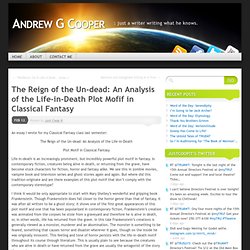

10 Moral Lessons From Christmas Carol. The Reign of the Un-dead: An Analysis of the Life-in-Death Plot Mofif in Classical Fantasy « Just Coop It. An essay I wrote for my Classical Fantasy class last semester: The Reign of the Un-dead: An Analysis of the Life-in-Death Plot Motif in Classical Fantasy Life-in-death is an increasingly prominent, but incredibly powerful plot motif in fantasy.

In contemporary fiction, creatures being alive in death, or returning from the grave, have become stock characters for fiction, horror and fantasy alike. We see this in zombie movies, vampire book and television series and ghost stories again and again. I think it would be only appropriate to start with Mary Shelley’s wonderful and gripping book Frankenstein. Next, we turn to Brom Stoker’s classic Dracula, in which the title character personifies the life-in-death plot motif. Another, much more common, example of this plot motif is ghosts. A Christmas Carol is a curios example of this however, because the ghosts—at least the first to ghosts of Christmas—are not something to be feared or that cause terror, as is popular with this motif. Works Cited. LOTHAR CERNY, Dickens' A Christmas Carol: Revisiting and Reformation. © Connotations 7.3 (1997-1998): 255-72 N.B.

For purposes of citation, page numbers of the printed version are inserted in square brackets. Dickens' A Christmas Carol: Revisiting and Reformation The prefix in revisiting points to the essential semantic aspect of the topic of this symposium. Whenever a place is revisited, whether in life or in literature, the past is involved and the relationship between the visitor and the past becomes the focus of interest. Perhaps I should say this relationship can become the focus of interest rather than becomes, because even the relationship to one's past and to the past generally is part of the cultural framework and subject to historical change.
The many examples of revisiting in Dickens are part of a larger pattern of dealing with the past which Dickens evolved throughout his career as a novelist. Revisiting as an act of remembrance is also a central aspect of A Christmas Carol, Dickens' comic as well as homiletic fairy-tale. Marley's Message. Charles Dickens's A Christmas Carol, 1843: An Introduction.
He tenth instalment of The Pickwick Papers (31 December 1836) had contained as 'a good-humoured Christmas Chapter' (XXVIII) "The Story of the Goblins who stole a Sexton.

" The tale's protagonist, the solitary, old bachelor-curmudgeon, the grave-digger Gabriel Grub, is the prototype of Ebenezer Scrooge. The visions and the beatings which the goblin king and his constantly smiling courtiers deliver serve to reintegrate the misanthropic Grub socially and restore him into a state of charity with the rest of humanity. This inset tale bears some obvious points of resemblance to A Christmas Carol , written seven years later. Although he had always venerated Christmas, Dickens did not consider writing another such story using the seasonal setting until 5 October 1843.
Invited to speak at the first annual general meeting of the Manchester Athenaeum (an adult education institute for the working class), Dickens had stayed with his beloved older sister Fan (now Mrs. Related Materials. A Christmas Carol: Metaphor Analysis Study Guide.